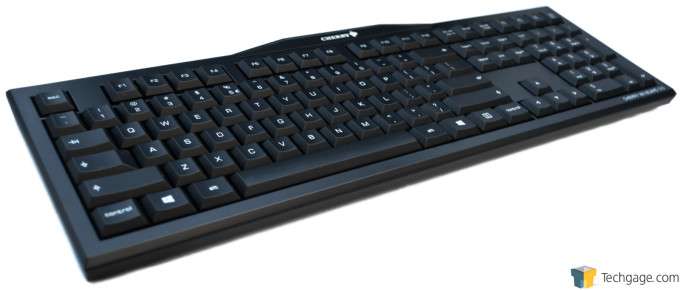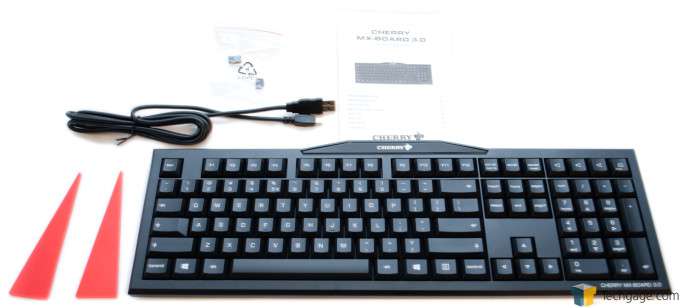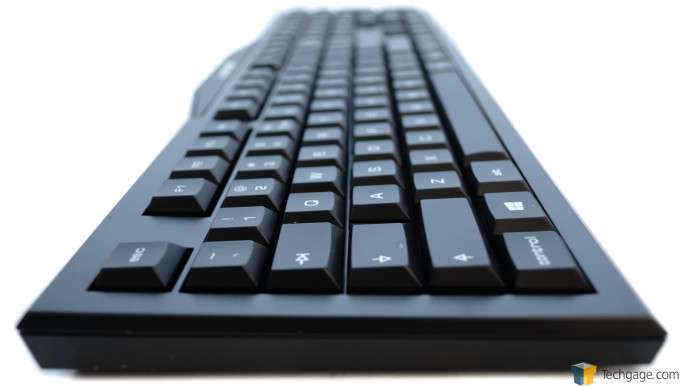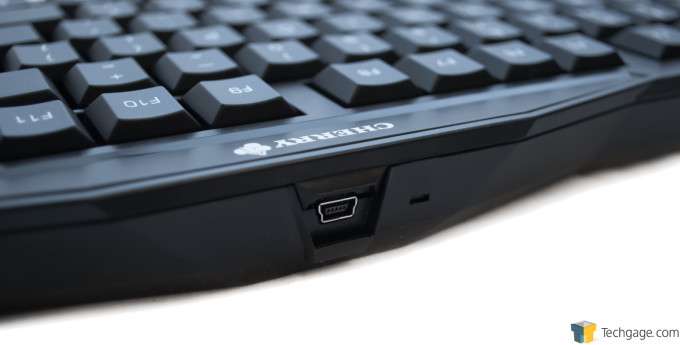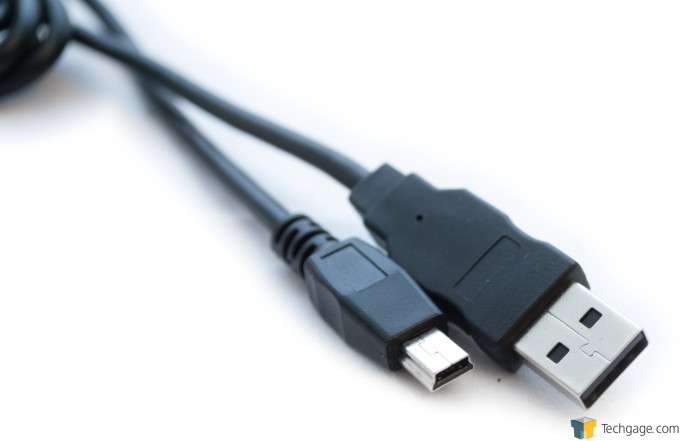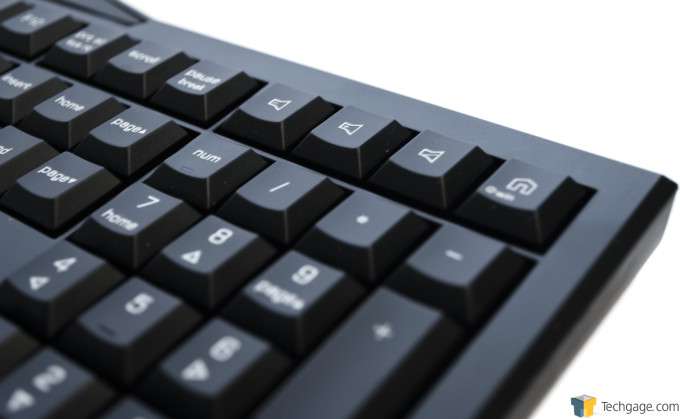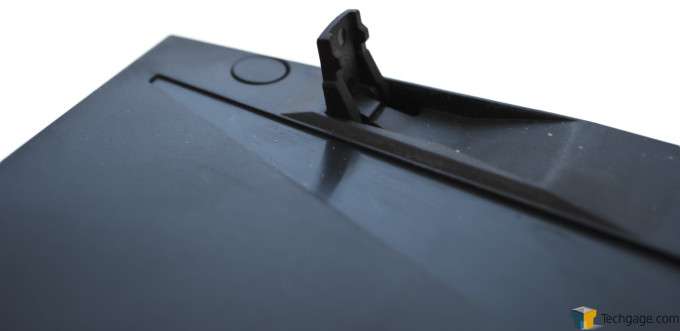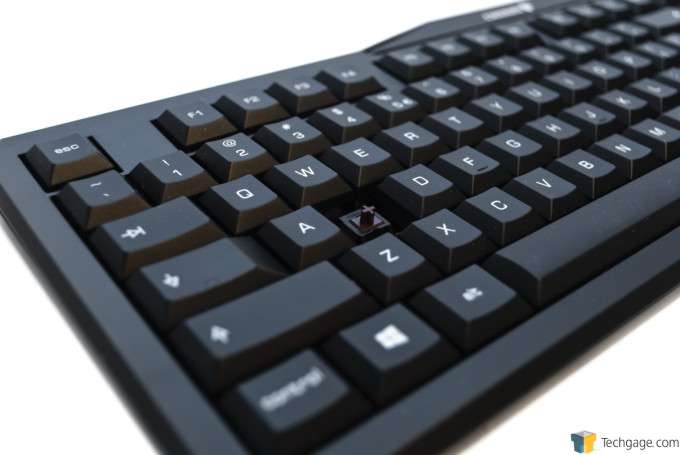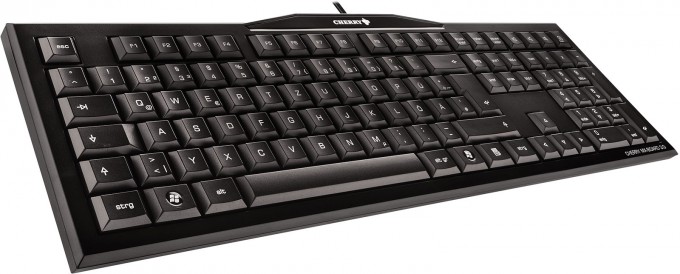- Qualcomm Launches Snapdragon 4 Gen 2 Mobile Platform
- AMD Launches Ryzen PRO 7000 Series Mobile & Desktop Platform
- Intel Launches Sleek Single-Slot Arc Pro A60 Workstation Graphics Card
- NVIDIA Announces Latest Ada Lovelace Additions: GeForce RTX 4060 Ti & RTX 4060
- Maxon Redshift With AMD Radeon GPU Rendering Support Now Available
CHERRY On Top? A Review Of CHERRY’s MX-Board 3.0 Professional Keyboard
CHERRY is famous for providing the most popular mechanical keyboard switches around, but did you know the company also manufactures its own line of mice and keyboards? In our lab is the company’s MX-Board 3.0, equipped with MX Brown switches. Let’s find out how interesting – or uninteresting – this plank is.
If you’re selling something, name recognition is invaluable. The most popular names are often associated with the very best products.
You don’t agree? Ever heard of Rolex? How about Gibson? Lamborghini, maybe?
It hardly even matters how one defines how it is to be the best. If you have a certain name, your stuff will almost sell itself.
The world of PC enthusiasts, really, is no different. Corsair. Lian Li. EVGA. ASUS.
Then there’s CHERRY. In its sphere of influence – mechanical keyboard switches – it is probably THE name.
If you’ve been paying attention to the ongoing surge of mechanical keyboards, then you’d know the German company makes the most popular types of key switches.
But did you know CHERRY manufactures not just its mechanical switches, but entire keyboards as well? I must confess that I was a bit surprised when I first learned that there are pukka all-CHERRY keyboards. Given the popularity of just the key switches it manufactures and sells to keyboard makers, it seems like an odd play. I mean, CHERRY is essentially competing against its own clients. Not that there’s anything wrong with that. I just wonder how big of a dent CHERRY would want to make in the market without potentially threatening its clients.
All this preamble brings us to our review subject, the CHERRY MX-Board 3.0 mechanical keyboard. CHERRY provided Techgage with a sample equipped with the MX Brown switch type. There is a variant equipped with the MX Red switches, but your humble scribe chose the MX Browns.
Let’s have a look at the MX-Board 3.0, now, shall we?
The CHERRY MX-Board 3.0 doesn’t really stand out, if I’m honest. It’s not styled like a typical gamer’s keyboard with aggressive angles, a humongous wrist rest, or rows and columns of extra keys. But it’s not as plain Jane as a simple rectangle either. The line of the MX-Board 3.0’s top edge does extend out into a shallow trapezoid, endowing this all-CHERRY plank with just a bit of visual flair. It’s also a handy place to put the company’s logo where everyone can see it, just in case anyone wants to ask about who made this product.
Here is a look at all that is included in the CHERRY MX-Board 3.0 package. There is the keyboard itself, of course. The two bright red wedges are the optional rubber feet which are meant to be stuck onto the keyboard’s bottom plane in perfectly shaped recesses. There is also the detachable USB cable as well a multi-language user’s guide. It’s a sparse accessories package, but it does contain almost everything you’ll need to use your MX-Board 3.0. To truly get the most out of it, you’ll need to download the KeyMan software from the CHERRY website.
There are a couple of details which make the MX-Board 3.0 distinctive compared to most of the mechanical keyboards I’ve tested.
Perhaps the most key of these distinctive features, if you’d pardon the pun, are the key caps on the MX-Board 3.0. They are quite low compared to virtually every other mechanical keyboard I’ve seen. I’m unsure why CHERRY decided to equip its keyboard with such low key caps; the only reason that makes sense to me is that perhaps CHERRY thinks this will help non-mechanical keyboard users accustomed to their typically low key cap heights make the transition to the MX-Board 3.0.
Another interesting detail is its detachable USB cable. Not to say that this feature is unique to this all-CHERRY keyboard; I’ve reviewed several mechanical keyboards already that have this very same feature (this was the last one I looked at that also featured a detachable USB cable). I don’t particularly appreciate the advantage of having a detachable cable on a corded peripheral – it’s just another potential point of failure, as far as I’m concerned – but CHERRY’s execution is simple and effective: The jack is mounted on the rear plane of the keyboard. This means that the cable won’t need to do any contortions for the connector to stay plugged in. So kudos to CHERRY for that smart design decision.
This is a shot of the USB cable ends. Pretty conventional, really.
The MX-Board 3.0 has an array of dedicated media volume control keys. Many mechanical keyboards do support media player functions, but do so with modified F keys. The MX-Board 3.0 has a set of dedicated volume +/- and Mute keys above the 10-key number pad. Pretty nifty of CHERRY to fit them onto the space available; to me that’s less clumsy than either having dual-function key sets or expanding the keyboard’s footprint to accommodate them.
Speaking of footprints, this is a shot of one of two flip-down feet on the bottom of the MX-Board 3.0. It’s not really a revolutionary or distinctive detail, but I’ve included a shot of it just for the sake of completeness.
I’ve also added a photo of the MX Brown key switch, just in case you’ve never seen one before. This shot, incidentally, also shows how low the key caps are compared to what we usually see on mechanical keyboards.
Now that we’ve done a visual tour of the CHERRY MX-Board 3.0, let’s put it through its paces and see how it performs.
Performance Testing
It’s been a while since I last reviewed a keyboard. Thankfully, reviewing one a very straightforward process. I’ll be evaluating the CHERRY MX-Board 3.0 on the basis of its ergonomics, its functionality, particularly once you’ve installed the KeyMan software, then ending with a few comments on my impressions on its build quality. I’ll also quantify its performance characteristics by telling you how fast and accurately I can type with this keyboard. It’s the same process I’ve used with every keyboard I’ve tested and reviewed for Techgage.
In terms of ergonomics the MX-Board 3.0 doesn’t stand out. While this might sound bad, it’s actually a good thing. I think keyboard ergonomics is a simple thing to talk about: Is it comfortable and easy to work with, or does its shape or layout make your hands, fingers, wrists or arms hurt? Although the key caps on the MX-Board 3.0 are lower and shallower than the ones installed on most other mechanical keyboards, they do not make typing on the MX-Board 3.0 feel much different, if at all.
I was a bit surprised by this, to be honest. Although I do have a couple of keyboards equipped with MX Brown switches, I presumed that the lower key caps would alter how the keyboard would feel under my fingers. Either I’m not sensitive enough to feel the difference, or there really isn’t a perceptible difference to feel in the first place.
Key placement is standard for the most part. The only non-standard keys are the volume control keys atop the 10-key array. This is as good a place as any for these, especially for a right-handed person like me. They’re out-of-the-way, so there is zero chance for accidental key presses. At the same time your dominant hand can find and use these keys sans issues. Southpaws might not agree, but as far as I’m concerned putting the volume control keys in a row above the number pad is fine.
Because it is such a basic keyboard, it doesn’t really need a wrist rest (although one exists as an add-on) or any other added features of that sort. In fact, I don’t even need to deploy the flip-feet, nor install the stick-on triangular rubber feet on the keyboard’s underside. It’s good that CHERRY provides for these types of adjustments, though, in case users might want/need them.
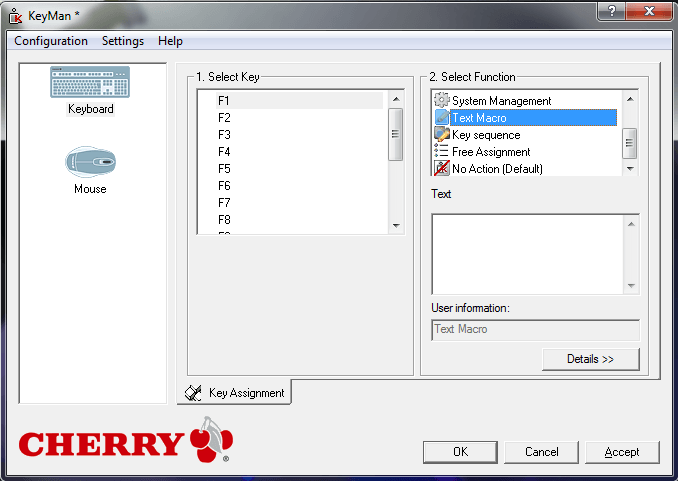
In terms of functionality, the MX-Board 3.0 just plain works. The media volume controls are an added value. Moreover, installing the KeyMan software (downloadable from CHERRY’s website) opens up a whole world of possibilities for the MX-Board 3.0. The KeyMan software not only allows you the ability to assign functions to the F keys, but it also allows you to record macro commands as well. Not bad for a keyboard that looks as basic as this.
As far as build quality goes, well, the MX-Board 3.0 is as good as any keyboard I’ve had my hands on. The chassis does exhibit some flex, but never to a disturbing degree. The quality of the markings on all the keys as well as all the branding seems good; you never get the sense that the printing will rub off far too quickly, even if your hands and fingers are prone to depositing high amounts of oils and general grub. The cable’s sleeving also inspires a similar impression of damage resistance.
As a typist’s tool, I’d say that performance on a keyboard depends quite a lot on its ergonomics as well as the type of key switches it is equipped with. We’ve already established that the MX-Board 3.0’s ergonomics is good; as far as key switches go, MX Browns are good enough for me. If you’ve been a regular Techgage reader from the past few years, you’d know that MX Blues are my favorite key switch. MX Browns are my third favorite (after the MX Greens). Consequently, I tend to type fastest on MX Blues.
I’m fairly fast on MX Browns as well, but not quite as good as I am on MX Blues. Using my standard test pattern on typingtest.com, I was able to average 83 wpm (words per minute) with 0 errors. If this seems a bit slow compared to my best average of 92 wpm/0 errors with my own daily driver keyboard, I think it has as much to do with my own degraded performance as it does with the fact the MX-Board 3.0 is equipped with MX Brown switches. I’ve not done a keyboard review for a while, so I can’t really say I’ve stayed as sharp as a typist. What I’m really trying to say here is that it’s not the keyboard’s fault why I’m about 10 percent slower than my best performance.
Final Thoughts
As prosaic as the CHERRY MX-Board 3.0 is at its core, it’s still a significant product. For one thing, it’s tangible proof that the company is fully capable of producing not just components, but an entire product as well. This would be akin to someone thinking that Toyota only builds engines, then finding out it makes entire automobiles too. It suggests that the company has a comprehensive knowledge and understanding about the market it serves.
The MX-Board 3.0 is also significant because it gives consumers another option. Options in the market drive competition, and competition tends to drive down prices.
Speaking of which, pricing for the MX-Board 3.0 seems to be variable. Newegg lists it at $91.99, while it is available at Amazon for $110.00. Newegg’s price puts the MX-Board 3.0 at the very bottom of the mechanical keyboard price range for products equipped with the MX Brown switch. But even the Amazon price is still reasonable.
The CHERRY MX-Board 3.0 probably won’t excite you too much, to be honest, but that’s really the only big shortcoming I can mention. While you can certainly use this for gaming, hard-core gamers will probably dismiss this plank just for lacking pizzazz. On the other hand, not everything good in this life is exciting. Reliability, dependability, functionality, and usability may not get your heart pumping hard and fast, but if you want a product that covers all these bases, with the added bonus of relative affordability, the MX-Board 3.0 is certainly worth a good, long look.
Pros
- Comfortable ergonomics.
- Solid build quality.
- Basic, but with expandable functionality.
- Distinctive (all-CHERRY product, has low keycaps).
- Affordable/very good value.
Cons
- Not that exciting.
Support our efforts! With ad revenue at an all-time low for written websites, we're relying more than ever on reader support to help us continue putting so much effort into this type of content. You can support us by becoming a Patron, or by using our Amazon shopping affiliate links listed through our articles. Thanks for your support!




